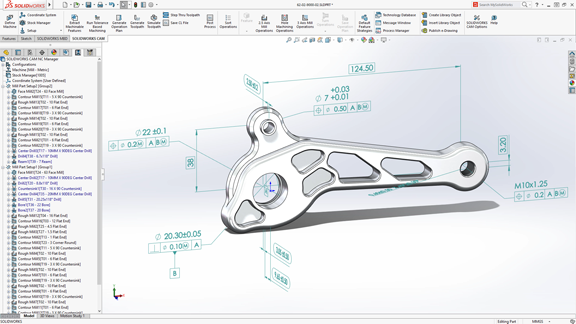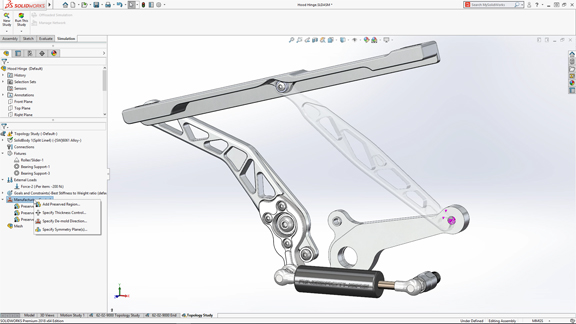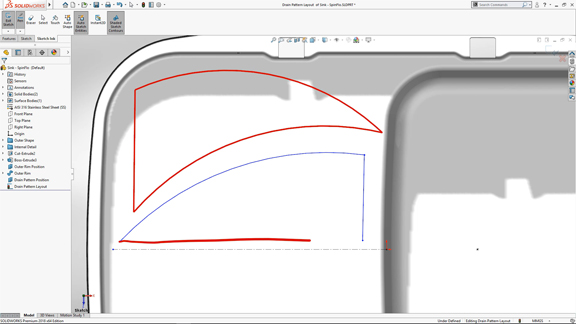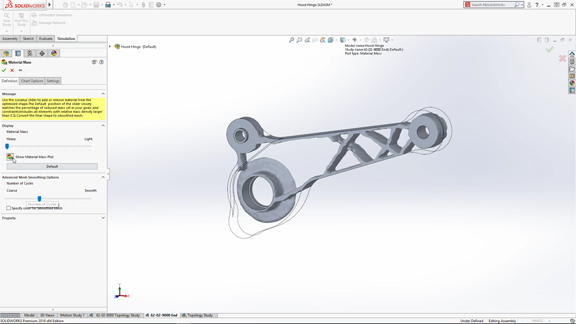
SolidWorks 2018 includes tolerance-based machining, part of the CAM features in the new release (image courtesy of SolidWorks).
October 10, 2017
The shift from mouse and keyboard to touch interface in CAD may be happening faster than people think. In launching SolidWorks 2018, the developers made a concerted effort to refashion the software for touch compatibility.
SolidWorks users have experimented with the software on touch devices in the past, though such usages were not officially sanctioned. This discussion thread about installing SolidWorks on Microsoft Surface appeared on SolidWorks user forum in late 2015, soon after the release of Microsoft Surface 3.
“I run SolidWorks on a Surface Pro 3, both 2015 and 2016, without any major issues,” noted Jeff Mirisola, long-time SolidWorks user and blogger.
The increase in processing power, both in CPU and GPU, and the larger memory footprint may have finally make CAD on tablet feasible. Newer touch-enabled, all-in-one tablets like the Lenovo ThinkStation P40 Yoga are powerful enough for professional CAD design software. (For more, read DE editor David Cohn’s review of the system.)
Touch interface in SolidWorks paves the way for VR-AR use of the software, where gestures and hand movements supplant mouse and keyboard as input devices.
 SolidWorks 2018 features Topology Study Tool, based on the technology from TOSCA by FE-Design, acquired by Dassault Systemes in 2013 (image courtesy of SolidWorks).
SolidWorks 2018 features Topology Study Tool, based on the technology from TOSCA by FE-Design, acquired by Dassault Systemes in 2013 (image courtesy of SolidWorks).CAD on Tablet
“SolidWorks 2018 is the first time we introduce touch interface” said Kishore Boyalakuntla, VP of product portfolio management, SolidWorks. “If you install SolidWorks 2018 on a system without touch interface, the touch-activated commands will be hidden. But if you have a touch-capable laptop or a tablet, like Microsoft Surface Book, you’ll be able to take full advantage of the touch-based features”
Sketching, one of the most basic operations in CAD modeling, could benefit the most from this new mode. “Many of our users reported seeing up to 30% improvement in sketching. The pen-based [or stylus-based] approach is somehow more artistic, it seems. Users tend to get an emotional reaction to it when using it for the first time,” observed Boyalakuntla.
Dassault Systemes, SolidWorks’ parent company, offers Natural Sketch, a sketching application tailored to stylus and tablet users. It’s part of Dassault Systemes’ CATIA product line. The touch-friendly sketching in SolidWorks, however, is a different technology developed by SolidWorks R&D, according to Boyalakuntla.
“We also see a lot of areas where we need to make touch work much better,” acknowledged Boyalakuntla.
 Touch-based drawing and sketching in SolidWorks 2018 anticipates the shift from mouse and keyboard to stylus (image courtesy of SolidWorks).
Touch-based drawing and sketching in SolidWorks 2018 anticipates the shift from mouse and keyboard to stylus (image courtesy of SolidWorks).Topology Optimization via TOSCA
SolidWorks 2018 introduces the Topology Study Tool, which you can use to “automatically optimize the shape of a design based on weight, function, and manufacturing criteria,” according to the company’s briefing document distributed to the press.
The tool is based on TOSCA, a product originally developed by FE-Design. In 2013, Dassault Systemes acquired FE-Design, bringing TOSCA into its SIMULIA portfolio. The optimization functions are included with SolidWorks Simulation Professional and SolidWorks Simulation Premium.
Topology optimization used to be available only in specialized simulation and modeling tools, such as Altair’s solidThinking Inspire. However, more recently, CAD vendors have begun delivering CAD-integrated topology optimization, which makes the technology more accessible to a wider user pool.
Simulation and modeling tasks in SolidWorks also benefit from refinement in the software’s meshing technology. “In SolidWorks 2018, a mesh model is an equal citizen to a Nurbs-based solid model. That means you can import CAT scans or environment scans and create designs around them,” said Boyalakuntla.
 Topology Study Tool lets you identify best shape or geometry based on stress loads (image courtesy of SolidWorks).
Topology Study Tool lets you identify best shape or geometry based on stress loads (image courtesy of SolidWorks).CAM for Subscribers
Subscribers of SolidWorks Standard, Professional, and Premium will find that they’re getting SolidWorks CAM Standard (for computer-aided manufacturing) with SolidWork 2018.
“Since it’s integrated into SolidWorks, the software automatically recognizes certain machining features, like holes and pockets. You won’t need to manually select them and specify them,” said Boyalakuntla.
SolidWorks’ CAM functions are derived from CAMWorks, developed by a SolidWorks Gold partner. “SolidWorks CAM provides ‘rules-based’ machining and automatic feature recognition to dramatically streamline NC programming,” according to SolidWorks’ blog post on the 2018 release.
“With it, experts within a company can save their CAM workflows so junior colleagues can initiate them and use them,” Boyalakuntla added.
SolidWorks CAM features tolerance-based machining, part of CAMWorks. Explaining the technology, CAMWorks writes, “Not only does CAMWorks automatically identify manufacturing features and automatically create toolpaths, CAMWorks will now recognize the tolerances and surface finishes associated with a feature to select the appropriate tools, speeds, feeds, etc… to generate the best toolpath.”
 SolidWorks 2018 includes tolerance-based machining, part of the CAM features in the new release (image courtesy of SolidWorks).
SolidWorks 2018 includes tolerance-based machining, part of the CAM features in the new release (image courtesy of SolidWorks).Taming the Data Jungle
The new release marks the debut of SolidWorks Manage, an enterprise-level data management tool.
“SolidWorks Manage is built on top of PDM (product data management). This is what allows you to manage projects, processes, bills of materials, dashboards, and reports,” explained Boyalakuntla. “Installation is usually less than half a day. It’s seamless in its connection to SolidWorks.
SolidWorks Manage was previewed at the company’s annual user conference SolidWorks World in February.
Another focus areas for this release is support for additive manufacturing. For details on these, read contributing editor Pamela Waterman’s post here.
Subscribe to our FREE magazine, FREE email newsletters or both!
About the Author
Kenneth Wong is Digital Engineering’s resident blogger and senior editor. Email him at [email protected] or share your thoughts on this article at digitaleng.news/facebook.
Follow DE





